
Adhesive manufacturing company Avery Dennison (NYSE: AVY) met Wall Street’s revenue expectations in Q3 CY2024, with sales up 4.1% year on year to $2.18 billion. Its non-GAAP profit of $2.33 per share wasalso in line with analysts’ consensus estimates.
Is now the time to buy Avery Dennison? Find out by accessing our full research report, it’s free.
Avery Dennison (AVY) Q3 CY2024 Highlights:
- Revenue: $2.18 billion vs analyst estimates of $2.20 billion (in line)
- Adjusted EPS: $2.33 vs analyst expectations of $2.35 (in line)
- EBITDA: $357.8 million vs analyst estimates of $358.3 million (small miss)
- Management slightly raised its full-year Adjusted EPS guidance to $9.43 at the midpoint
- Gross Margin (GAAP): 28.7%, in line with the same quarter last year
- EBITDA Margin: 16.4%, in line with the same quarter last year
- Free Cash Flow Margin: 10.4%, down from 12.4% in the same quarter last year
- Organic Revenue rose 4% year on year (-11.4% in the same quarter last year)
- Market Capitalization: $17.1 billion
“We delivered a strong third quarter with strong earnings growth, above expectations, driven by higher volume and productivity gains,” said Deon Stander, president and CEO.
Company Overview
Founded as Kum Kleen Products, Avery Dennison (NYSE: AVY) is a manufacturer of adhesive materials, display graphics, and packaging products, serving various industries.
Industrial Packaging
Industrial packaging companies have built competitive advantages from economies of scale that lead to advantaged purchasing and capital investments that are difficult and expensive to replicate. Recently, eco-friendly packaging and conservation are driving customers preferences and innovation. For example, plastic is not as desirable a material as it once was. Despite being integral to consumer goods ranging from beer to toothpaste to laundry detergent, these companies are still at the whim of the macro, especially consumer health and consumer willingness to spend.
Sales Growth
A company’s long-term performance is an indicator of its overall business quality. While any business can experience short-term success, top-performing ones enjoy sustained growth for multiple years. Over the last five years, Avery Dennison grew its sales at a sluggish 4.2% compounded annual growth rate. This shows it failed to expand in any major way and is a rough starting point for our analysis.
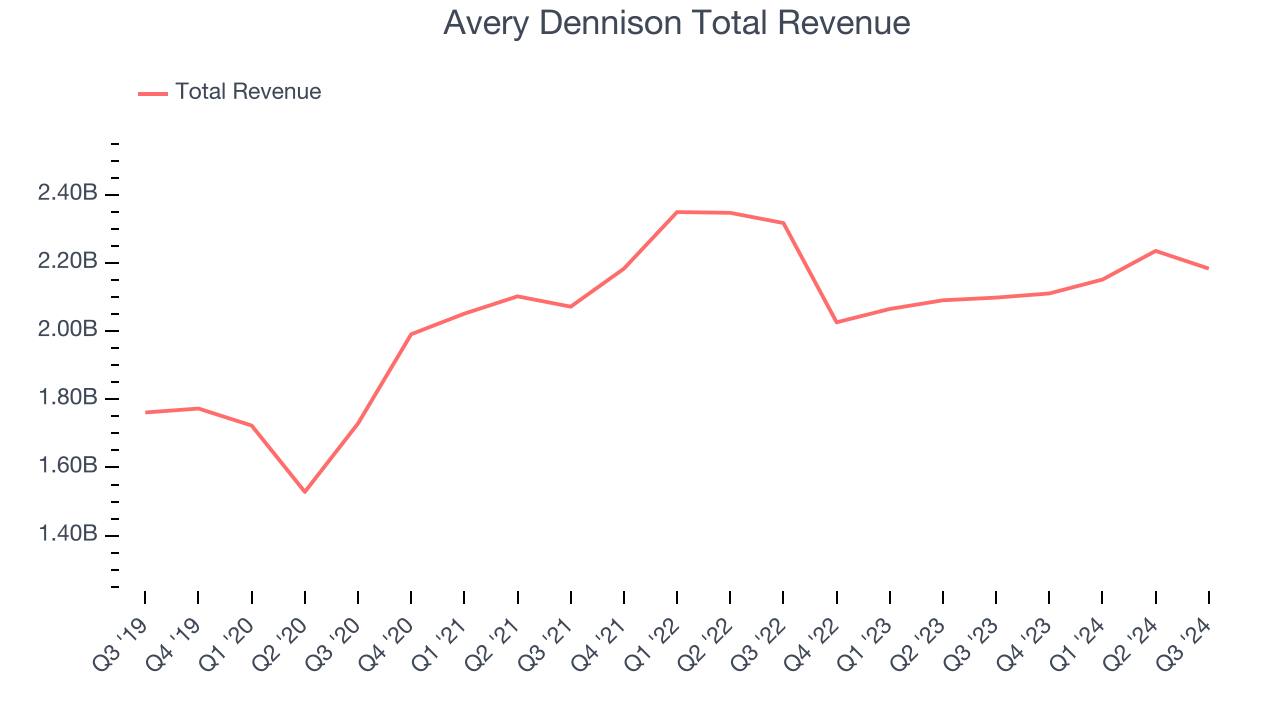
We at StockStory place the most emphasis on long-term growth, but within industrials, a half-decade historical view may miss cycles, industry trends, or a company capitalizing on catalysts such as a new contract win or a successful product line. Avery Dennison’s history shows it grew in the past but relinquished its gains over the last two years, as its revenue fell by 2.8% annually. Avery Dennison isn’t alone in its struggles as the Industrial Packaging industry experienced a cyclical downturn, with many similar businesses seeing lower sales at this time.
We can dig further into the company’s sales dynamics by analyzing its organic revenue, which strips out one-time events like acquisitions and currency fluctuations because they don’t accurately reflect its fundamentals. Over the last two years, Avery Dennison’s organic revenue averaged 2.1% year-on-year declines. Because this number aligns with its normal revenue growth, we can see the company’s core operations (not M&A) drove most of its performance. 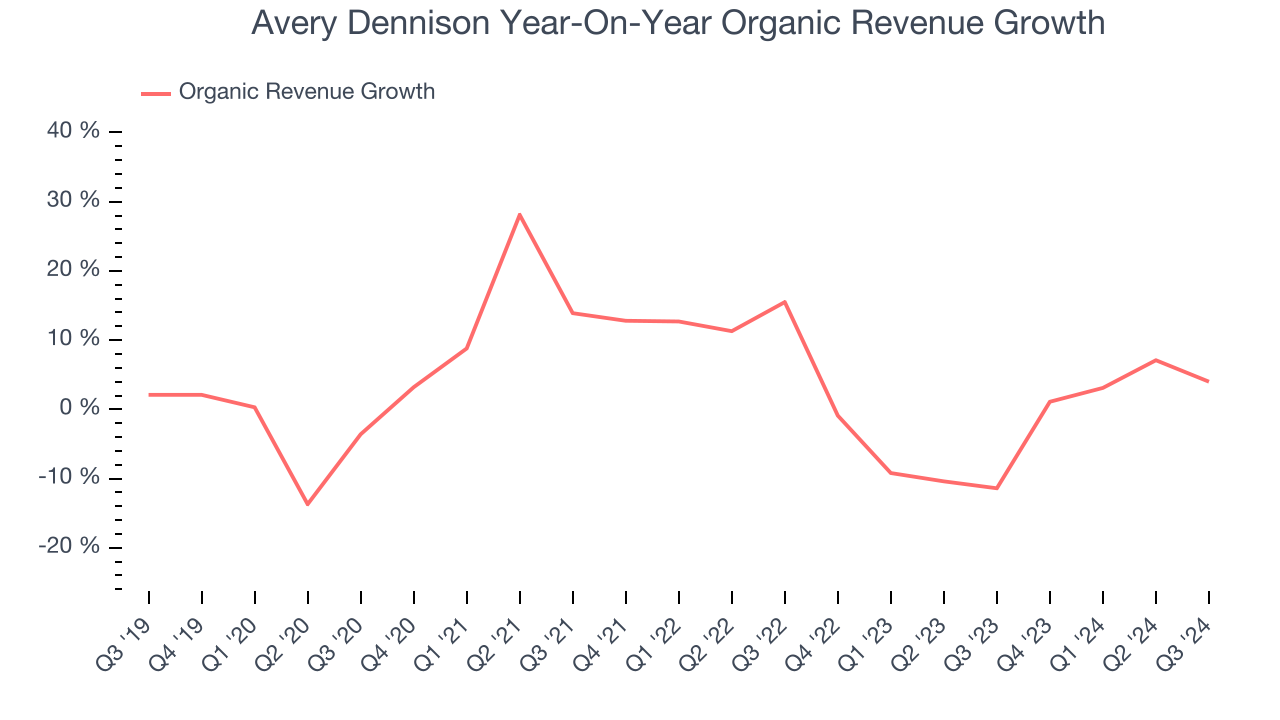
This quarter, Avery Dennison grew its revenue by 4.1% year on year, and its $2.18 billion of revenue was in line with Wall Street’s estimates.
Looking ahead, sell-side analysts expect revenue to grow 4.8% over the next 12 months, an acceleration versus the last two years. While this projection indicates the market believes its newer products and services will spur better performance, it is still below the sector average.
Today’s young investors won’t have read the timeless lessons in Gorilla Game: Picking Winners In High Technology because it was written more than 20 years ago when Microsoft and Apple were first establishing their supremacy. But if we apply the same principles, then enterprise software stocks leveraging their own generative AI capabilities may well be the Gorillas of the future. So, in that spirit, we are excited to present our Special Free Report on a profitable, fast-growing enterprise software stock that is already riding the automation wave and looking to catch the generative AI next.
Operating Margin
Analyzing the trend in its profitability, Avery Dennison’s annual operating margin might have seen some fluctuations but has generally stayed the same over the last five years, highlighting the long-term consistency of its business.
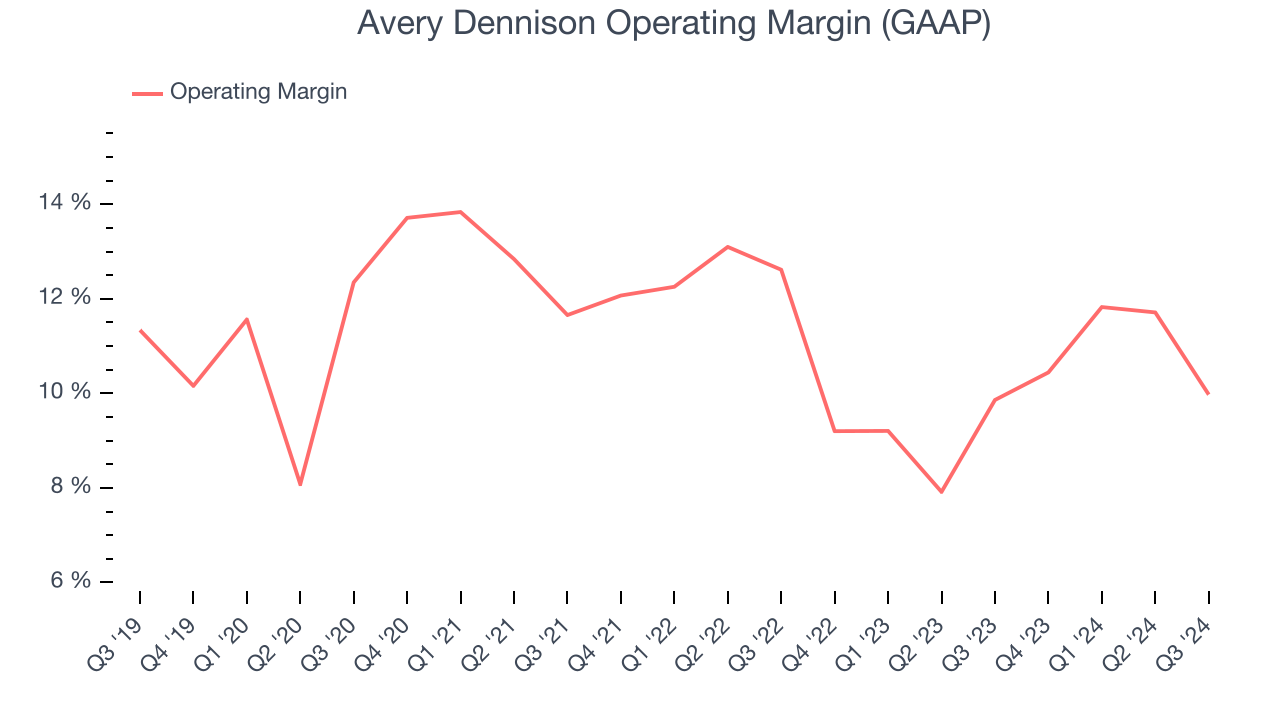
This quarter, Avery Dennison generated an operating profit margin of 10%, in line with the same quarter last year. This indicates the company’s cost structure has recently been stable.
Earnings Per Share
We track the long-term growth in earnings per share (EPS) for the same reason as long-term revenue growth. Compared to revenue, however, EPS highlights whether a company’s growth was profitable.
Avery Dennison’s EPS grew at an unimpressive 7.5% compounded annual growth rate over the last five years. This performance was better than its 4.2% annualized revenue growth but doesn’t tell us much about its day-to-day operations because its operating margin didn’t expand.
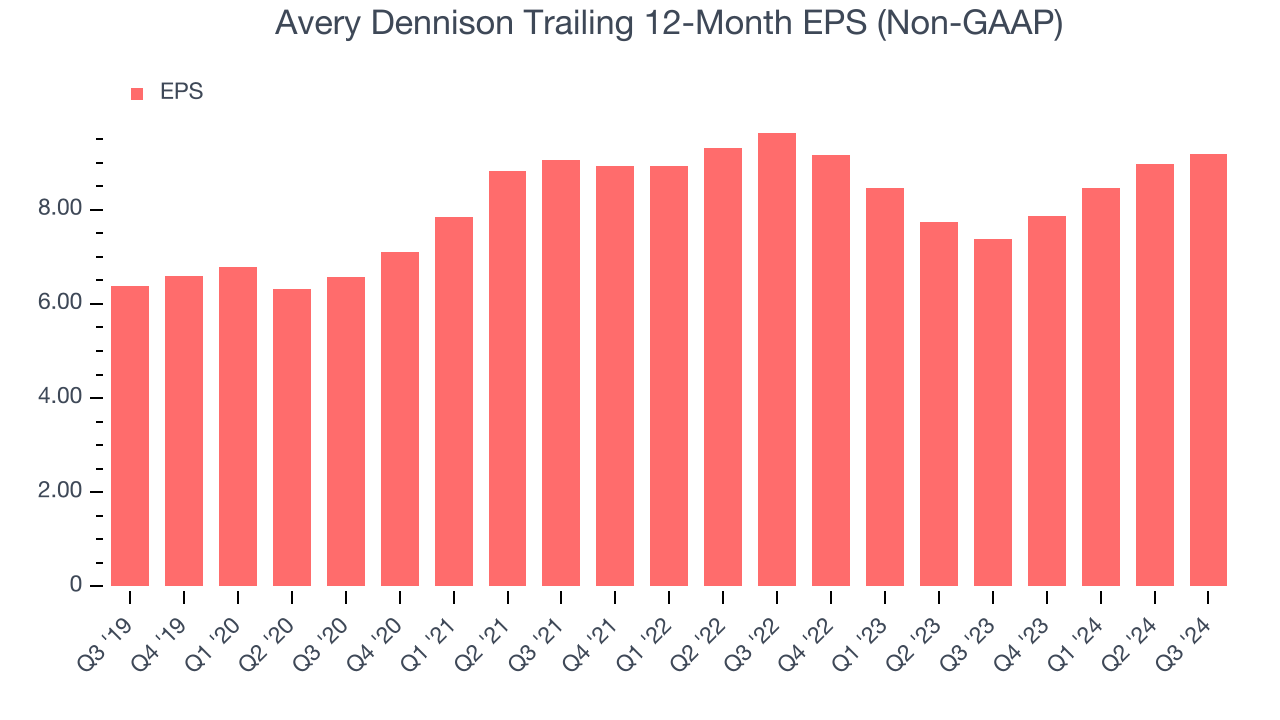
Diving into the nuances of Avery Dennison’s earnings can give us a better understanding of its performance. A five-year view shows that Avery Dennison has repurchased its stock, shrinking its share count by 4.7%. This tells us its EPS outperformed its revenue not because of increased operational efficiency but financial engineering, as buybacks boost per share earnings. 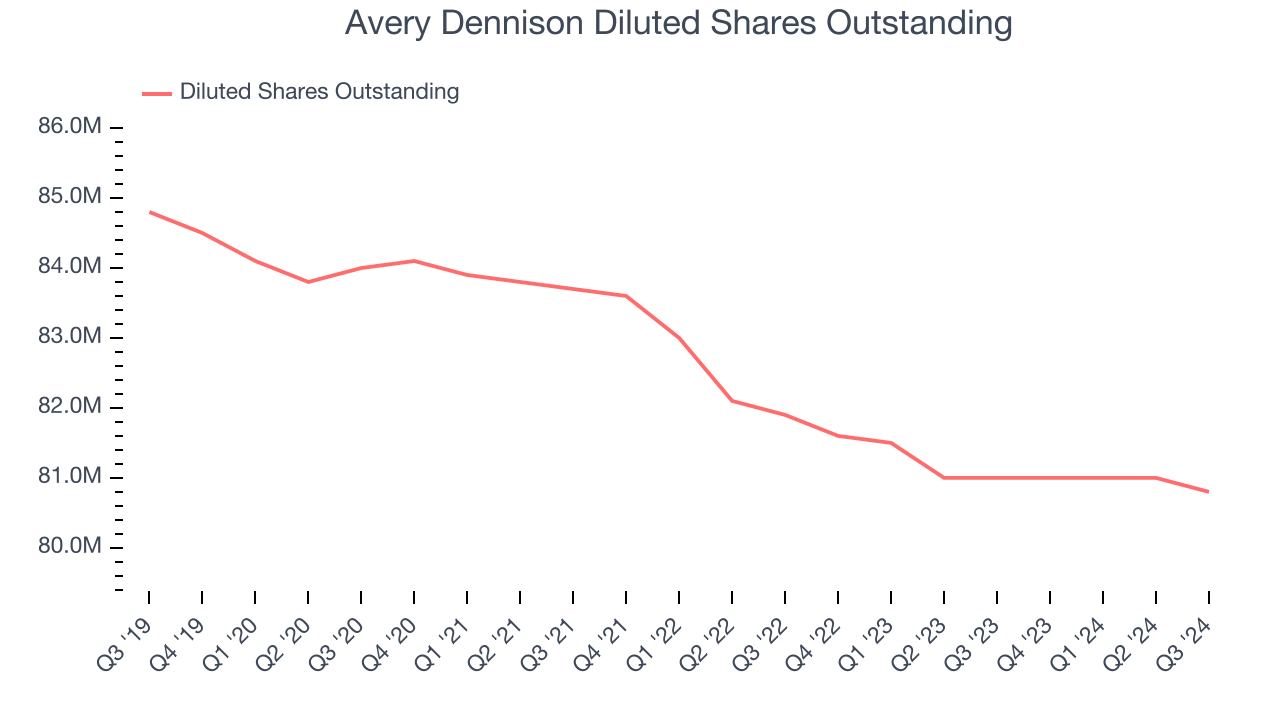
Like with revenue, we analyze EPS over a more recent period because it can give insight into an emerging theme or development for the business. For Avery Dennison, its two-year annual EPS declines of 2.3% show it’s continued to underperform. These results were bad no matter how you slice the data.
In Q3, Avery Dennison reported EPS at $2.33, up from $2.10 in the same quarter last year. This print was close to analysts’ estimates. Over the next 12 months, Wall Street expects Avery Dennison’s full-year EPS of $9.19 to grow by 12.8%.
Key Takeaways from Avery Dennison’s Q3 Results
The quarter itself was underwhelming, with Avery Dennison missing slightly on key metrics. A bright spot was that full year EPS guidance was raised. However, raising guidance when slightly missing in the quarter can bring about some market skepticism. Overall, this quarter could have been better. The stock remained flat at $211.50 immediately following the results.
Avery Dennison may have had a tough quarter, but does that actually create an opportunity to invest right now?When making that decision, it’s important to consider its valuation, business qualities, as well as what has happened in the latest quarter. We cover that in our actionable full research report which you can read here, it’s free.





